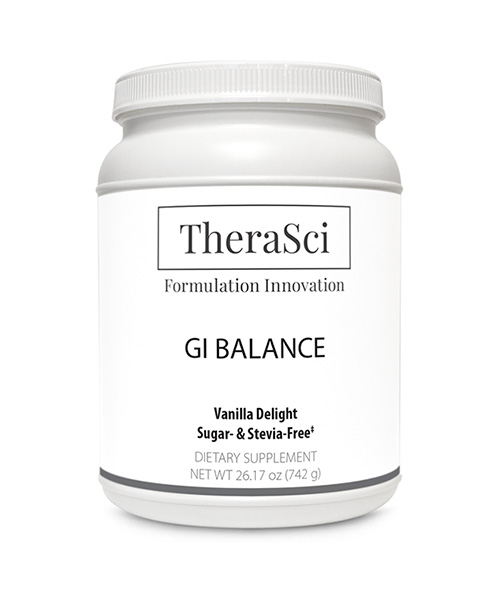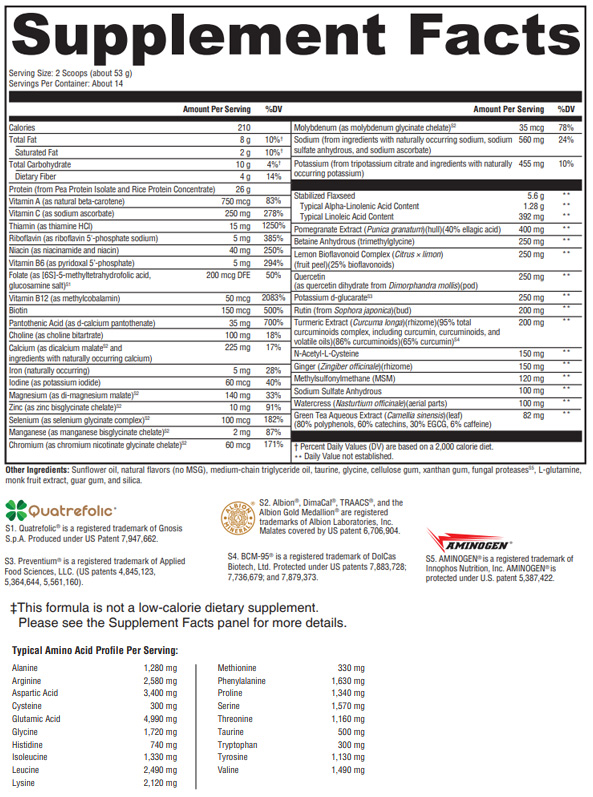GI Balance

Clinical Applications
- Supports Natural Detoxification Mechanisms*
- Supports Gastrointestinal Health*
- Supports a Balanced Cytokine Profile*
- Lactose-Free Vegan Protein*
GI Balance is a comprehensive, monk-fruit-extract-sweetened, low-allergy–potential dietary supplement designed to support gastrointestinal (GI) function and balanced detoxification. It features Vegan Protein Blend, TheraSci, LLC’s proprietary amino acid and pea/rice protein blend; Aminogen®, to facilitate protein absorption; phytonutrients; mineral amino acid chelates; and activated B vitamins, including Quatrefolic® and methylcobalamin. In conjunction with a modified elimination diet, GI Balance addresses GI and hepatic function as well as eicosanoid balance and cytokine metabolism. This formula is suitable for vegans.*
All TheraSci, LLC Formulas Meet or Exceed cGMP Quality Standards
Discussion
GI Balance is now sweetened with a natural, high-potency sweetener extracted from monk fruit. This generally recognized as safe (GRAS) monk-fruit extract offers a high-quality sweetness and flavor without the bitter aftertaste associated with some natural sweeteners.
Protein Metabolism
Vegan Protein Blend is TheraSci, LLC’s proprietary blend of pea protein isolate and rice protein concentrate, L-glutamine, glycine, and taurine. Generation of glutathione and sulfation cofactors—vital for phase II conjugation—requires an array of amino acids. The combination of pea protein and rice protein, containing a complement of amino acids, achieves an amino acid score of 100%. Glutamine, a conditionally essential and versatile amino acid with two nitrogen moieties, is crucial to nitrogen metabolism and helps maintain healthy liver tissue and function.[1,2] The amino acid glycine is needed for bile synthesis, phase II detoxification, and glutathione production. Taurine, a derivative of the sulfur-containing amino acid cysteine, is also important for synthesis of bile salts and helps stabilize cell membranes.*
Gastrointestinal Support
Ginger root, included to support healthy digestion such as the release of bile from the gallbladder, acts at several sites to moderate PGE(2) production and support the normal response to inflammation.[3] Fiber (from inulin and flaxseeds) supports production of short-chain fatty acids as well as a healthy intestinal flora. MeadowPure™, an organic flaxseed complex, possesses excellent oxidative stability, supports antioxidant activity, and provides lignins, soluble fiber, and omega-3 and omega-6 essential fatty acids.[4] Glutamine plays a key role in healthy intestinal cell proliferation and gut barrier integrity, immune function, and normal tissue healing.*[1,2]
Detoxification Support
Ellagic acid (from pomegranate extract) prevents over-induction of CYP1A enzymes, works at the gene level to induce synthesis of glutathione-S-transferases and other phase II activities, binds directly to toxins, and protects DNA and hepatocytes.[5,6] Watercress is a rich source of beta-phenylethyl isothiocyanate (PEITC)—a versatile compound found to inhibit phase I enzymes and induce the phase II enzymes associated with biotransformation and excretion of toxins. Watercress has been found to contain even stronger phase II inducers known as 7-methylsulfinyheptyl and 8-methylsulfinyloctyl isothiocyanates as well.[7,8] Green tea catechins not only support antioxidant activity but also appear to act as modulators of phase I and phase II detoxification.[9] Choline is present to support lipid metabolism in the liver and can be converted to betaine, a methyl donor.*[10]
The active, bioavailable form of B vitamins (pyridoxal-5’-phosphate (B6), 5-methyltetrahydrofolate (folate), methylcobalamin (B12)) and glycine all support amino acid conjugation and are vital for the detoxification of xenobiotics and xenoestrogens. 5-methyltetrahydrofolate (5-MTHF), methylcobalamin, betaine, and methylsulfonylmethane (MSM) are present to support methylation and detoxification. 5-MTHF supports healthy folate nutrition, especially in individuals with variations in folate metabolism. In GI Balance, 5-MTHF is provided as Quatrefolic® for enhanced stability, solubility, and bioavailability.*[11]
Preventium®, a patented form of potassium hydrogen d-glucarate, supports glucuronidation. Sulfation is supported by MSM and sodium sulfate. Acetylation is supported by d-calcium pantothenate, pyridoxal-5’-phosphate, and magnesium. Several minerals in GI Balance are provided as Albion® mineral chelates and TRAACS® mineral amino acid chelates for enhanced gastrointestinal absorption and bioavailability.*[12]
Antioxidant Support and Cytokine Balance
Bioflavonoids, quercetin, rutin, and curcumin support antioxidant activity, counter free radicals, and support healthy eicosanoid and cytokine metabolism.[13,14] Curcumin has a long history of use for its support of a normal, healthy response to inflammation.[15] N-acetyl-cysteine (NAC) stimulates glutathione synthesis, enhances glutathione-S-transferase activity, and promotes detoxification.[16] Selenium glycinate provides support for glutathione metabolism and antioxidant protection.*

Directions
Consult your healthcare professional prior to use. Individuals taking medication should discuss potential interactions with their healthcare professional. Do not use if tamper seal is damaged.
Does Not Contain
References
1. Smith RJ, Wilmore DW. Glutamine nutrition and requirements. JPEN J Parenter Enteral Nutr. 1990 Jul-Aug;14(4 Suppl):94S-99S. Review. [PMID: 2119461]
2. Lacey JM, Wilmore DW. Is glutamine a conditionally essential amino acid? Nutr Rev. 1990 Aug;48(8):297-309. Review. [PMID: 2080048]
3. Lantz RC, Chen GJ, Sarihan M, et al. The effect of extracts from ginger rhizome on inflammatory mediator production. Phytomedicine. 2007 Feb;14(2-3):123-28. [PMID: 16709450]
4. Adolphe JL, Whiting SJ, Juurlink BH, Thorpe LU, Alcorn J. Health effects with consumption of the flax lignan secoisolariciresinol diglucoside. Br J Nutr. 2010 Apr;103(7):929-38. Review. [PMID: 20003621]
5. Barch DH, Rundhaugen LM, Stoner GD, et al. Structure-function relationships of the dietary anticarcinogen ellagic acid. Carcinogenesis. 1996 Feb;17(2):265-9. [PMID: 8625448]
6. Girish C, Koner BC, Jayanthi S, et al. Hepatoprotective activity of picroliv, curcumin and ellagic acid compared to silymarin on paracetamol induced liver toxicity in mice. Fundam Clin Pharmacol. 2009 Dec;23(6):735-45. [PMID: 19656205]
7. Rose P, Faulkner K, Williamson G, et al. 7-Methylsulfinylheptyl and 8-methylsulfinyloctyl isothiocyanates from watercress are potent inducers of phase II enzymes. Carcinogenesis. 2000 Nov;21(11):1983-8. [PMID: 11062158]
8. Hofmann T, Kuhnert A, Schubert A, et al. Modulation of detoxification enzymes by watercress: in vitro and in vivo investigations in human peripheral blood cells. Eur J Nutr. 2009 Dec;48(8):483-91. [PMID: 19636603]
9. Akhlaghi M, Bandy B. Dietary green tea extract increases phase 2 enzyme activities in protecting against myocardial ischemia-reperfusion. Nutr Res. 2010 Jan;30(1):32-39. [PMID: 20116658]
10. Linus Pauling Institute. http://lpi.oregonstate.edu/infocenter/othernuts/choline/. Accessed May 8, 2012.
11. Quatrefolic. http://www.quatrefolic.com/. Accessed May 8, 2012.
12. Albion. http://www.albionminerals.com/. Accessed May 8, 2012.
13. Garg R, Gupta S, Maru GB. Dietary curcumin modulates transcriptional regulators of phase I and phase II enzymes in benzo[a]pyrene-treated mice: mechanism of its anti-initiating action. Carcinogenesis. 2008 May;29(5):1022-32. [PMID: 18321868]
14. Amália PM, Possa MN, Augusto MC, et al. Quercetin prevents oxidative stress in cirrhotic rats. Dig Dis Sci. 2007 Oct;52(10):2616-21. [PMID: 17431769]
15. Jurenka JS. Anti-inflammatory properties of curcumin, a major constituent of Curcuma longa: a review of preclinical and clinical research. Altern Med Rev. 2009 Jun;14(2):141-53. Review. Erratum in: Altern Med Rev. 2009 Sep;14(3):277. [PMID: 19594223]
16. Kelly GS. Clinical applications of N-acetylcysteine. Altern Med Rev. 1998 Apr;3(2):114-27. Review. [PMID: 9577247
*These statements have not been evaluated by the Food and Drug Administration. This product is not intended to diagnose, treat, cure, or prevent any disease.
